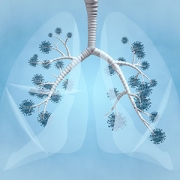Study compares outcomes of SARS-CoV-2 versus other respiratory viruses

Until now, little was known about the incidence and virus-specific patient outcome of SARS-CoV-2 compared to common seasonal respiratory viruses in children — including respiratory syncytial virus (RSV), human parainfluenza (hPIV), human metapneumovirus (hMPV), respiratory adenovirus and human rhinovirus (hHRV) and respiratory enterovirus (rENT).
Common respiratory viral infections were associated with a higher proportion of inpatient admissions but were similar in intensive care unit (ICU) admissions and death rates in hospitalized pediatric patients when compared to SARS-CoV-2, according to Children’s National Hospital researchers that led a study published in Infection Control & Hospital Epidemiology.
Until now, little was known about the incidence and virus-specific patient outcome of SARS-CoV-2 compared to common seasonal respiratory viruses in children — including respiratory syncytial virus (RSV), human parainfluenza (hPIV), human metapneumovirus (hMPV), respiratory adenovirus and human rhinovirus (hHRV) and respiratory enterovirus (rENT).
The researchers also noted that there was an overall substantial decrease in seasonal respiratory viral infections, especially the severe forms that require hospitalization. They believe that this correlation might be associated with the adoption of COVID-19 public health mitigation efforts, which played a major role in the reduction of these viruses that often circulate in fall and winter. The retrospective cross-sectional cohort study analyzed over 55,000 patient admissions between Match 15 and December 31, 2020. The findings shed light on the incidences of eight common seasonal respiratory viral infections before and during the COVID-19 pandemic. It also compared patient outcomes associated with COVID-19 and these other viral infections among pediatric patients at Children’s National.
Xiaoyan Song, Ph.D., M.Sc., chief infection control officer at Children’s National, spoke to us about the study.
Q: Why is this important work?
A: This is the first study to date that has described and compared hospitalization rates, ICU admission rates and death associated with COVID-19, RSV, seasonal influenza, rhinovirus, enterovirus and other common respiratory viral infections in children in one study. Previously, studies have compared one or two viruses at a time. This study compared 8 viruses, including the most detected ones – COVID-19, RSV, seasonal flu, rhinovirus and enterovirus.
Q: How will this work benefit patients?
A: This study will inform patients, families and the public that preventative measures like masking, hand hygiene, avoiding crowds and avoiding people who are ill are good practices that work to protect children from getting COVID-19 but also from getting infected with RSV, influenza and other viruses. Any of these respiratory viruses could harm a patient to a point where the child may have to be hospitalized or receive ICU care.
You can read the full study published in Infection Control & Hospital Epidemiology.







